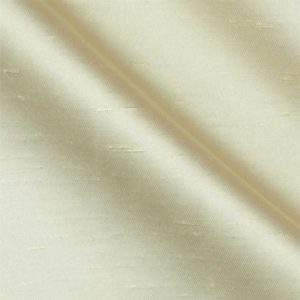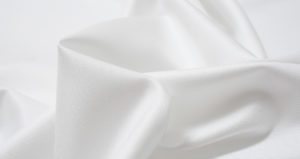 Silk - fabric of natural origin. It is obtained from the cocoon of an insect pupa, which is called the “silkworm”. Nowadays, you can find not only natural, but also artificial silk, as well as material with the addition of synthetics.
Silk - fabric of natural origin. It is obtained from the cocoon of an insect pupa, which is called the “silkworm”. Nowadays, you can find not only natural, but also artificial silk, as well as material with the addition of synthetics.
Silk fibers were first produced in China. It was in the Celestial Empire that a special technology for manufacturing this wonderful material was discovered back in the 5th millennium BC. For a long time it was kept in the strictest confidence.
There are a huge number of types of silk fabrics. Their main differences are in their weaving technology, which gives them their unique features and appearance.
Atlas
 Satin is a shiny and dense silk fabric. The surface of the satin is usually smooth, but the material can also be patterned. The satin has a characteristic shine, the front side resembles gloss. This effect is achieved using a special production technology.
Satin is a shiny and dense silk fabric. The surface of the satin is usually smooth, but the material can also be patterned. The satin has a characteristic shine, the front side resembles gloss. This effect is achieved using a special production technology.
The type of weaving of this fabric, like raw silk itself, was invented in China.Together with the technique of producing material from silkworm cocoons, this knowledge came first to Central Asia and then to Europe, where the material became widespread.
Gas (illusion, rice, marabou, crystal)
This is a translucent silk fabric, which is achieved by the large space between its threads. The gas is very light and soft. In the manufacture of different types of gas, patterned, smooth and diagonal weaving is used.
 Illusion gas is the thinnest and almost transparent material, reminiscent of a light cobweb. Made from the finest silk yarn. Curtains, light scarves, and elements of wedding decorations are made from it.
Illusion gas is the thinnest and almost transparent material, reminiscent of a light cobweb. Made from the finest silk yarn. Curtains, light scarves, and elements of wedding decorations are made from it.
Gas-rice is light, transparent and slightly rough. The texture is achieved thanks to a special rice weave. Hence the name.
Gas marabou is a rather stiff golden material made from raw silk, made from tightly twisted threads. It was widespread at the beginning of the 18th century. Used for sewing fluffy women's dresses.
Gas crystal has a bright shine. In its production, multi-colored threads are used, causing the surface to shimmer like precious stones. In France, chic ball gowns were made from it.
Crepe
 The name of the material is translated from French as “wavy”, “rough”. When making crepe, the threads are twisted left and right, alternating in a certain way.
The name of the material is translated from French as “wavy”, “rough”. When making crepe, the threads are twisted left and right, alternating in a certain way.
This fabric is characterized by an uneven surface. The texture is somewhat similar to sand.
The crepe drapes perfectly, lays down in beautiful waves, and does not wrinkle. Things made from it last a very long time.
In addition to silk crepe, it can be made of cotton, wool blend, or synthetic. Nowadays it is used mainly for women's dresses.
Organza
 Thin translucent lightweight fabric made of silks. It comes in matte and glossy.Patterns are embroidered on organza and original designs are applied using printing. Oriental dance costumes and curtains are often made from it.
Thin translucent lightweight fabric made of silks. It comes in matte and glossy.Patterns are embroidered on organza and original designs are applied using printing. Oriental dance costumes and curtains are often made from it.
Silk-Satin
 Satin comes from the word "zaytuni" - the Arabic name for Quanzhou Harbor in China, the birthplace of this fabric. Silk-satin has a smooth, dense surface, which is characterized by a beautiful shine. Bed linen, men's shirts, and lining are made from it.
Satin comes from the word "zaytuni" - the Arabic name for Quanzhou Harbor in China, the birthplace of this fabric. Silk-satin has a smooth, dense surface, which is characterized by a beautiful shine. Bed linen, men's shirts, and lining are made from it.
Silk-satin is made from two types of material - 100% cotton sateen and pure silk. The weave density of this fabric is 170–220 threads per 1 square meter. cm.
Important! Linen made from silk-satin is very strong and durable. It can withstand over 200 washes, does not fray, and is cheaper than silk..
Taffeta
 Fabric made from tightly twisted silk and cotton threads. Synthetic fibers are often involved in production. Taffeta is distinguished by its high density and rigidity. Forms brittle folds, which allows you to achieve additional volume and fluffiness.
Fabric made from tightly twisted silk and cotton threads. Synthetic fibers are often involved in production. Taffeta is distinguished by its high density and rigidity. Forms brittle folds, which allows you to achieve additional volume and fluffiness.
Toile
 The toile is distinguished by high density and delicate shine. This fabric holds its shape excellently and is used as a lining for sewing dresses and ties.
The toile is distinguished by high density and delicate shine. This fabric holds its shape excellently and is used as a lining for sewing dresses and ties.
Chiffon
A very thin, airy material made from tightly twisted silk threads. It is transparent, light and flows beautifully. Perfect for sewing summer blouses and light scarves.
Chesucha (wild silk)

Chesucha is a wild dense silk with an amazing texture. In production, threads of unequal thickness are used, which form such a surface. It is durable, drapes well, but requires delicate care. Chesucha is used in sewing curtains and various clothes.
Foulard
 Foulard is most often used as a finishing material. Thin and soft silk fabric from which shawls, scarves and scarves are sewn.In the 20th century, dresses, curtains and lampshades were also made from foulard.
Foulard is most often used as a finishing material. Thin and soft silk fabric from which shawls, scarves and scarves are sewn.In the 20th century, dresses, curtains and lampshades were also made from foulard.
DuPont
 Dense curtain fabric of medium hardness, with a pleasant shine. This exclusive fabric consists almost entirely of natural silk. DuPont made in India is especially valued. Wedding and evening dresses, accessories and expensive bed linen are made from it.
Dense curtain fabric of medium hardness, with a pleasant shine. This exclusive fabric consists almost entirely of natural silk. DuPont made in India is especially valued. Wedding and evening dresses, accessories and expensive bed linen are made from it.
Crepe georgette
 Silk fabric made using crepe weaving. The front surface of crepe georgette is shiny and rough.
Silk fabric made using crepe weaving. The front surface of crepe georgette is shiny and rough.
Important! The difference between crepe georgette and other types of crepe is the direction of weaving. During production, the warp and weft threads are twisted in different directions. This makes it dense, but light and elastic.
During the era of balls, fashionable women's toilets were made from crepe georgette. Now this fabric is not so popular. It is used to make draped curtains, as well as some models of skirts, blouses and scarves.
Crepe de Chine
 Type of silk crepe fabric - hgrainy with crepe twisting technology. It has a moderate shine, is dense and fine. Shawls, suits, and blouses are made from crepe de Chine.
Type of silk crepe fabric - hgrainy with crepe twisting technology. It has a moderate shine, is dense and fine. Shawls, suits, and blouses are made from crepe de Chine.
Important! Soft flowing folds and draperies are a characteristic feature of this material.
Silk pontagage
 Epontage (or pongee) is distinguished between silk and cotton. The material has an uneven spongy surface with a decorative color pattern in the form of cells, stripes, and melange.
Epontage (or pongee) is distinguished between silk and cotton. The material has an uneven spongy surface with a decorative color pattern in the form of cells, stripes, and melange.
Brocade
 Brocade has always been considered the fabric of nobles, royalty and church ministers. This heavy material is made from silk with a complex pattern made with metal thread. Previously, the pattern was made with threads from alloys of gold and silver. This explains the high cost of the material.
Brocade has always been considered the fabric of nobles, royalty and church ministers. This heavy material is made from silk with a complex pattern made with metal thread. Previously, the pattern was made with threads from alloys of gold and silver. This explains the high cost of the material.
Nowadays, patterns on brocade are embroidered not only from hard metal threads. Use threads made of linen, silk or cotton.
Muslin
 Muslin is made from high-wrap natural silk. The material is transparent and thin. Used for sewing theatrical costumes and dresses.
Muslin is made from high-wrap natural silk. The material is transparent and thin. Used for sewing theatrical costumes and dresses.
Twill
 Twill (Italian sargia, French serge; from Latin sericus - “silk”) - twill production technology - weaving threads diagonally. Each subsequent thread offsets the intersection by 2 or more other threads. Twill is produced plain-dyed or printed. Used as lining, technical or dress fabric, for sewing workwear.
Twill (Italian sargia, French serge; from Latin sericus - “silk”) - twill production technology - weaving threads diagonally. Each subsequent thread offsets the intersection by 2 or more other threads. Twill is produced plain-dyed or printed. Used as lining, technical or dress fabric, for sewing workwear.
Excelsior, excelsior
 Plain weave silk fabric with a distinct sheen, fine and transparent. In production, untwisted thread is used. Excelsior drapes well. The fabric is quite beautiful. It is used by designers who work with batik, as well as those who create silk flowers and decorative elements.
Plain weave silk fabric with a distinct sheen, fine and transparent. In production, untwisted thread is used. Excelsior drapes well. The fabric is quite beautiful. It is used by designers who work with batik, as well as those who create silk flowers and decorative elements.
Charmeuse
 Charmeuse is very similar to satin. Both have a smooth front surface with a characteristic shine. The difference can be determined by feeling the material: charmeuse is thinner and softer than satin.
Charmeuse is very similar to satin. Both have a smooth front surface with a characteristic shine. The difference can be determined by feeling the material: charmeuse is thinner and softer than satin.
Silk cambric
 Silk cambric contains approximately 3% silk, which gives things shine. Plain weave is used for its production. Batiste flows beautifully and forms elegant folds. Good for long dresses.
Silk cambric contains approximately 3% silk, which gives things shine. Plain weave is used for its production. Batiste flows beautifully and forms elegant folds. Good for long dresses.
Whatever type of silk you choose, the main thing is to avoid synthetic fakes and you can be confident in the quality of the product. Silk does not cause allergies, and clothes made from it, if properly cared for, will please you for many years.


 1
1






Maria, hello! I read your article with pleasure and learned a lot of new and interesting things. You managed to present a large amount of interesting information very concisely. Thank you!
PS. Unfortunately, there are errors: inconsistency between feminine and masculine genders, singular and plural.